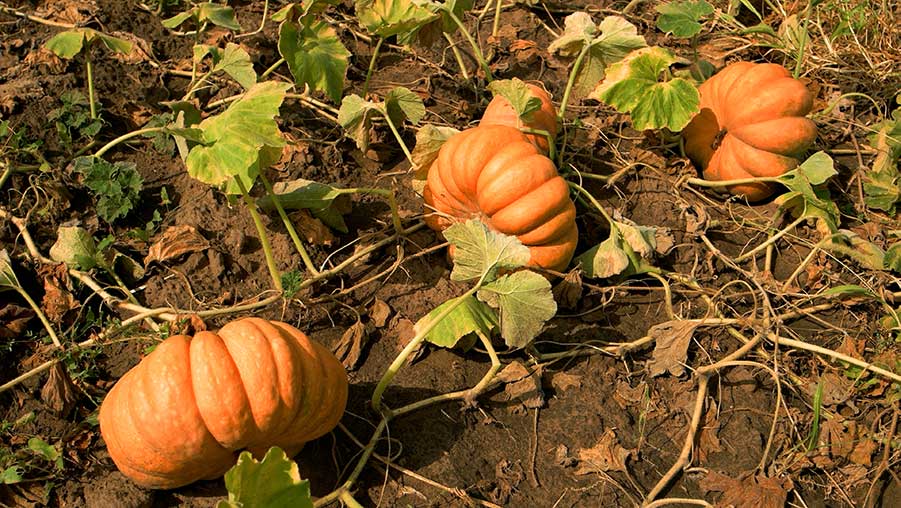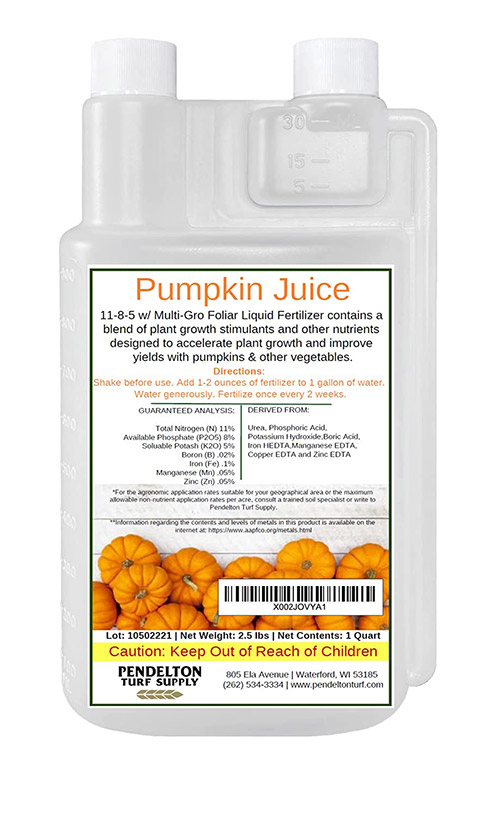Pumpkins are one of the most rewarding vegetables to grow in the garden. Not only are they delicious and nutritious, but they are also fun to harvest and decorate with. Their sheer size is impressive, and their beautiful orange color helps them stand out in the fall landscape.
That’s enough about why you should grow pumpkins, though. Let’s talk about how to make sure your pumpkins are the best they can be. One of the most important things you can do for your pumpkins is to make sure they have the right fertilizer. That’s what this article is about – finding the best pumpkin fertilizer for healthy harvests.
Pumpkins thrive in soil that is rich in nutrients. If you have aged compost or manure, that would make an excellent addition to the soil around your pumpkin plants. I even remember my mother planting pumpkins in just a few years old compost which resulted in the biggest pumpkins I’ve seen to this day.
However, not everyone has access to aged compost or manure. It can also be tricky to find the right balance of nutrients when using natural fertilizers. That’s where a good commercial fertilizer comes in.
What to look for in pumpkin fertilizer

You’ll want to look for a fertilizer that is high in nitrogen, potassium, and phosphorus. These nutrients are essential for growth and will help your pumpkins thrive.
Normally on a fertilizer package, these numbers will be listed in that order as the NPK (nitrogen – N, phosphorus – P, and potassium – K) ratio. For example, a 10-10-10 fertilizer has an equal balance of all three nutrients. A 20-10-5 fertilizer has twice as much nitrogen as phosphorus and potassium.
The kind of fertilizer you choose depends on many factors, including the kind of pumpkin you’re growing, its growth stage and your soil type. This can sound a tad bit overwhelming. If you’re looking into serious gardening it might be worth doing soil test. This will help you find out what nutrients are lacking in your soil so you can target those specifically.
While that approach will maximize your pumpkin yield, it’s not necessary for the average home gardener. A good all-purpose fertilizer will work just fine. These will be the ones we will look at in this article – fertilizers with a good mix of nitrogen, phosphorus, and potassium.
Let’s take a look at what those nutrients mean and how they will benefit your pumpkins.
Nitrogen
Nitrogen helps your plants produce more chlorophyll, which is responsible for photosynthesis. In other words, it helps your plants turn sunlight into food. Nitrogen is also necessary for the production of proteins, which are essential for cell growth.
Potassium
Potassium is important for the overall health of your plants. It helps with water regulation, disease resistance, and winter hardiness. Potassium is also necessary for the production of enzymes and for the synthesis of carbohydrates.
Phosphorus
Phosphorus is essential for root growth, flower production, and seed formation. It also helps your plants store energy and resist stress.
Phosphorus is especially important when your pumpkins are flowering and setting fruit. A lack of phosphorus can result in small, deformed fruits.
How to use a pumpkin fertilizer
Now that you know a bit more about the nutrients your pumpkins need, let’s talk about how to actually use pumpkin fertilizer.
Normally fertilizers come either in a dry granular form or as a liquid concentrate. If you’re using a granular fertilizer, you’ll need to spread it around the base of your plants and then water it in. For a liquid fertilizer, you will have to mix it with water according to the package directions and then apply it to your plants.
It’s best to fertilize your pumpkins right during their planting. This will give them a good head start and help them to grow strong and healthy. You can also fertilize your pumpkins again when they start to vine out, and then once more when they start to set fruit. Some people prefer to fertilize their plans more frequently – it’s best to check the instructions for the kind of pumpkin fertilizer you choose.
Finally, let’s take a look at some specific fertilizers that would be good for your pumpkins.
5 Best Pumpkin Fertilizers Reviews
Here’s a quick breakdown of my top picks and what these pumpkin fertilizers will be best for:
- Fertilizer Especially for Pumpkins: Pumpkin Juice Foliar Liquid Fertilizer
- Best Fertilizer for all Edible Plants: Miracle-Gro Performance Edible Plant Nutrition Granules
- For transplanting or re-potting: Wallace Organic Wonder, Super Starter Packs
- Most affordable option: Burpee Natural Purpose Granular Organic Food
- For Blooming and Fruiting: Elm Dirt’s Bloom Juice
Pumpkin Juice Foliar Liquid Fertilizer: Made Especially for Pumpkins

Pumpkin Juice fertilizer is made especially for pumpkin plants. As there are not a lot of fertilizers made with only pumpkins in mind, it already makes the list as one of the best pumpkin fertilizers. Pumpkin Juice has an NPK ratio of 11-8-5 and also contains essential micronutrients like Boron, Iron, Manganese and Zinc to ensure healthy growth. There aren’t a lot of fertilizers on the market that are made specifically for pumpkins, so this is a great option if you’re looking for something particular for your orange beauties.
The bottle has a measuring system built into the bottle to make things easier. You just mix the required amount of fertilizer with water and spray it on the leaves and soil of your plants. This is called foliar feeding and is a great way to give your plants a quick boost of nutrients while they’re growing. It’s recommended to use it every 2 weeks for best results.
PROS:
- Made specifically for pumpkins
- Contains additional essential micronutrients
- Easy to use measuring system
CONS:
- Can’t think of any, it’s really all around a great product
Miracle-Gro Performance Edible Plant Nutrition Granules: Best Fertilizer for all Edible Plants

This is a great all-purpose fertilizer made specifically for edible plants so it will work well for your pumpkins. It has an NPK ratio of 7-6-9 and is derived from 100% organic sources like feather meal, bone meal, and sunflower hull ash.
It’s a granular fertilizer that you spread around the base of your plants and then water in which works great when you’re just planting your pumpkins. You can also use it throughout the growing season to give your plants an extra boost – it’s recommended to use it every 4-6 weeks.
PROS:
- Made specifically for edible plants
- It’s organic
- Can be used throughout the growing season
CONS:
- Some people don’t like granular fertilizers because they can be a bit messy
Wallace Organic Wonder, Super Starter Packs: For transplanting or re-potting

I have to say that the packaging of these is quite impressive – they feature giant pumpkins on the front to really drive home the point that it’s meant to boost the growth of your pumpkins. While your pumpkins might not grow to the size of the ones on the package, it’s still a great pumpkin fertilizer. It’s made particularly for planting or transplanting and comes in little biodegradable bags that you should just put in the ground without opening and they will slowly break down and release the nutrients.
The Wallace Organic Wonder fertilizer has an NPK ratio of 10-3-6 and it’s main “secret” is a fungus called Mycorrhizae, with the addition of an all-natural organic fertilizer and a season-long 5-month slow-release fertilizer.
PROS:
- Good for transplanting or re-potting
- The bags are biodegradable
- Contains Mycorrhizae which help the plant to take up nutrients
CONS:
- Can be tricky to use if you have a lot of pumpkins since you need to put a bag for each one
Burpee Natural Purpose Granular Organic Food: The Most affordable option

Burpee is certified organic by the OMRI so you can be sure that this fertilizer is the real deal. It’s a granular fertilizer that you spread around the base of your plants and then water in. It has an NPK ratio of 4-4-4 and is made from 100% organic ingredients.
This is a very affordable option and can be used during different stages of pumpkin growth – from planting to blooming and fruiting. It’s recommended to use it every 2-4 weeks for best results. Keep in mind that this is the most “general” fertilizer with the lowest NPK ratio but if you’re looking for a fertilizer to use on all your outdoor (and even indoor) plants, this can be a good starting point.
PROS:
- It’s organic and certified by the OMRI
- Can be used for different stages of growth
- Very affordable
CONS:
- Some people might prefer a fertilizer with a higher NPK ratio
Elm Dirt’s Bloom Juice: For Blooming and Fruiting
This is a great fertilizer for pumpkins to use during the blooming and fruiting stages as it has a high phosphorus content which is necessary for blooming and fruiting. It also has a good amount of potassium which is important for overall plant health.
It’s made from all-natural and organic ingredients like bone meal and yucca. Elm Dirt’s Bloom Juice is also made in the USA (in a woman-owned business) and is safe for people, pets, and the environment. So not only your pumpkins will love it, you will too.
PROS:
- Good for blooming and fruiting
- All-natural and organic
- Safe for people, pets, and the environment
CONS:
- You’ll need a measuring cup since it doesn’t come with one
So, what’s the best pumpkin fertilizer?
There is no easy answer to what is the best fertilizer for pumpkins as it depends on a few factors such as your budget, the stage of growth of your pumpkins, and your personal preferences.
However, I would recommend Pumpkin Juice if you’re looking for fertilizer made specifically for pumpkins and Miracle-Gro Performance Nutrition Granules if you’re looking for an affordable all-purpose fertilizer.
Do you have any best pumpkin fertilizer recommendations that made your pumpkins grow like crazy? Let us know in the comments below.

